Year: 1987 |Publisher: Broderbund/Namco|Developer: Nihon Falcom |Original format: MSX | Version played: NES
The first Dragon Slayer game to be released in the west, Falcom’s Dragon Slayer IV: Drasle Family reached US shores in 1989 when Broderbund localised the Famicom port for NES, renaming it Legacy Of The Wizard. It’s largely forgotten now, especially here in Europe where the game was never released. But it does seem to have achieved a cult status in the US where those who did play it have praised it as a hidden gem and an early example of the burgeoning Metroidvania genre.

I’m not sure I ever would have played it had I not developed a little obsession with Nihon Falcom, following the release of Ys VIII, which took me on a journey through the developer’s whole catalogue, including the original Dragon Slayer on MSX, but I’m glad I did! This is a really interesting and richly detailed game that I don’t think enough people talk about.
The first thing that jumps out about the fourth Dragon Slayer game is that it’s not an RPG at all. There are no experience points and you don’t need to worry about stats or upgrades. It’s pure side-scrolling action but with the depth and sense of exploration you might ordinarily associate with an RPG. Though it’s the fourth game in the series, received wisdom has it that each of the Dragon Slayer games is its own thing, completely unrelated from the others and simply collected under the same branding for marketing purposes.
When you look at the series as whole, this is certainly true. The sixth game, Legend Of Heroes, is a traditional Dragon Quest-style JRPG. The seventh, Lord Monarch, is an epic god game where direct control is sacrificed for deep strategy and management elements. While the fifth, Sorcerian, is an open-ended dungeon crawler where you can design any party you like to explore and conquer endless dungeons supplied via multiple expansion disks. It’s fascinating how much variety there is in this series, and as a Metroidvania, Legacy Of The Wizard definitely stands out from its peers. And yet…
I have to admit I do see some similarities; some shared elements that suggest there are a few strands of DNA running throughout the Dragon Slayer series, despite the rhetoric that these are completely unrelated games. Perhaps it’s because so far, the only other game I’ve played in the series is the first one, but I do see some definite connections.
For one thing, both games have a mechanic that rewards you for repeatedly returning to your house. In the first game you can carry “power stones” back home in order to level up, but in Legacy Of The Wizard you’re not the only one who lives in the house! This time it’s home to the Worzen family, or the Drasle family in the Japanese version, and returning to the house allows you to select any one of them to take on an adventure in the dungeons below and take the opportunity to choose three items to take with you.
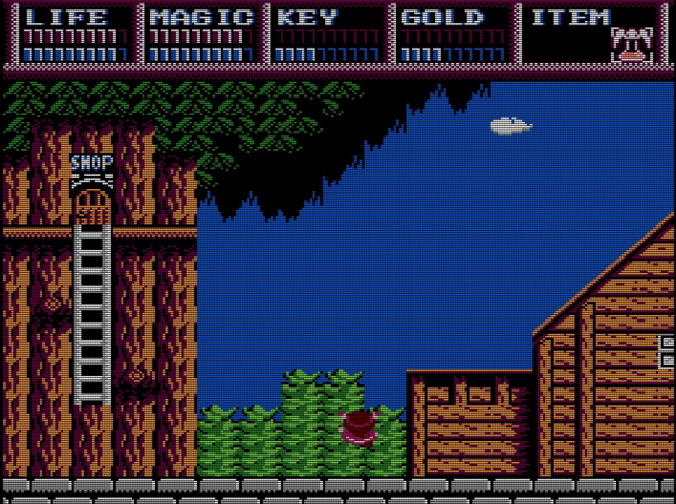
I’m a big fan of the character select screen, in which selecting one of the family members from around the dinner table visibly transforms them into an armoured warrior or robed mage. Even the family dog, Pochi, can be selected and transforms into a cute little monster that reminds me a lot of Tamagon, the little green dragon from Nintendo’s Devil World.
Those five playable family members are the key to Legacy Of The Wizard. The USP that adds further depth to the Metroidvania is also a complicating factor that at times makes the game feel opaque and inaccessible. As you might expect, each of the characters has slightly different attributes. Some are stronger, while others can jump higher. Each also has items that only they can use; although they may be found somewhere that only another character can reach. The vast, labyrinthine dungeon is designed with these character differences in mind, so navigating the maze isn’t just about unlocking weapons and powers that might help you overcome certain obstacles, it’s also about knowing which character to employ in the right place at the right time. There are entire sections of the dungeon that the designers only intended for certain characters to be able to enter, and the passages leading toward them are often be designed to make it impossible for anyone but the intended character to make it through. Although smart players have since figured out some sneaky workarounds… Something that could keep me up all night if I dared to ponder whether Falcom’s designers actively anticipated this kind of sequence breaking and built in such exploits on purpose. Honestly, the design of some of the puzzles is so obtuse at times that this wouldn’t surprise me!
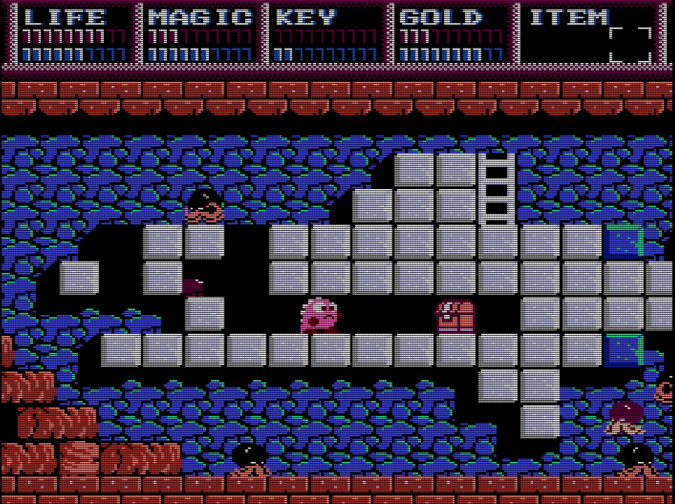
Nowhere is the difference between the family members felt more meaningfully than in the other feature Legacy Of The Wizard notably shares with the original Dragon Slayer… The block pushing mechanics! Those who have read my post on that game may recall that I was impressed by the extent to which block pushing pervaded the entire design. With the right equipment and attitude you could rearrange the geometry of almost the entire world in Dragon Slayer. Heck, you could even push your own house around if you wanted to!
Legacy Of The Wizard doesn’t quite offer that same level of freedom. Only a certain type of block can be interacted with, so that the rest of the level design is left intact to create fixed puzzles and routes throughout. But it’s the versatility in the many different ways you can interact with those blocks that impresses this time around.
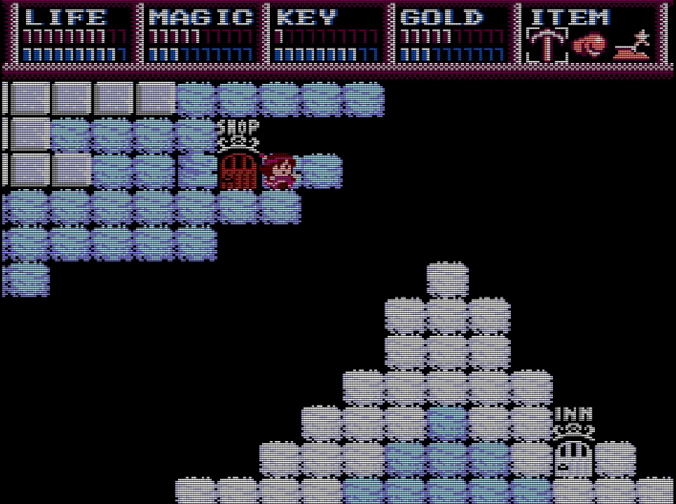
When armed with the mattock (a pickaxe to you and me) the daughter of the family, Lyll can destroy any of the interactive blocks. More interestingly, her mother, Meyna, can use a magic rod to strike a block and send it flying around, bouncing off the walls until it runs out of kinetic energy and killing any enemy it runs over in its course. Finally, the father, Xemn, can use a pair of gloves to push a block one square at a time in any given direction. His power is most similar to the one in the original Dragon Slayer and by far the most complicated. At first, I naturally assumed that this skill was for solving mazes and blocked tunnels, merely using the gloves to move a block out of your way. But after watching a video guide, I realised there’s much more potential than that… After all, this is no top-down game, and you can move the blocks in ANY direction. So if you’re smart you can arrange said blocks into platforms so you can reach areas that the other characters can’t. This creates what trendy game designers might call a vast “possibility space” where your ability to manipulate the world offers multiple solutions to each problem.

Intermission… If you want to play Legacy Of The Wizard today, the easiest way is via Namco Museum Archives Vol. 2, available on Steam, PS4, Xbox One and Nintendo Switch. This collection was called Namcot Collection in Japan and focuses solely on NES/Famicom games released by Namco, who released Dragon Slayer IV on Famicom back in the day. I’m not quite sure how they have the rights to Broderbund’s NES release of the game but it’s pretty cool that they do. The compilation is pretty great, by the way. It has a handful of great NES games including an entirely new port of Gaplus, developed by M2 especially for this collection.
While some areas of the game are clearly designed for one particular character, it’s even more impressive when an area can be revisited by multiple characters and approached in a totally different way because of their different skills. I can’t imagine the next-level game design genius that would be necessary to put that kind of space together. There’s a beauty to this design. It has a depth that only becomes more apparent as you play and as the systems unfold before you.
At first you might notice that Pochi as a monster can’t be hurt by the other monsters in the game. So he makes a perfect beginner character. He can explore the dungeon practically risk-free, scope out the rooms for the others and collect a few key items to take back to the house. Maybe you’ll realise that equipping the jump boots to Lyll, the character with by far the highest natural jump ability, makes it possible to reach so high you might even be able to jump up the screen above. Though you’ll also jump so high that you could take damage when you land!

There are countless examples of such strategies or tricks that will help you conquer Legacy Of The Wizard. It’s genuinely mind boggling at times. So much so, that I question how many people could beat this game without a guide. Heck, I question how many people can even work out what the fundamental goals of the game are. Especially if you’re playing a digital version and don’t have access to the original manual.
In many respects, Legacy Of The Wizard reminds me of another early Metroidvania with multiple characters and obscure/obtuse puzzles… Konami’s The Maze Of Galious. Let’s conveniently forget that, in my blog post, I insisted it was a Zelda-like rather than a Metroidvania and recognise that both of these games are very much of their era; games in which their huge depth is both a blessing and a curse.
Incidentally, I prefer Maze Of Galious to Legacy Of The Wizard. Its structure – with the Zelda-like dungeons populating a larger maze – offers a greater sense of progression, and its use of two characters rather than five results in a simpler and slightly more flexible ruleset. But that’s by the by.
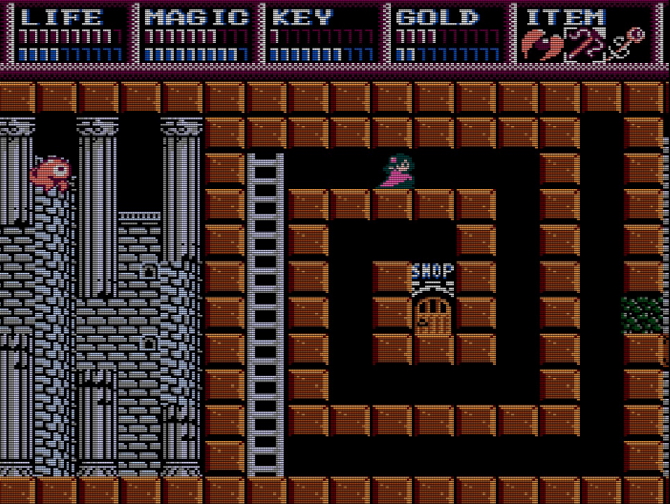
Like Maze Of Galious, Legacy Of The Wizard feels like one of the games that was designed in the assured knowledge that there would also be guide books available to buy alongside it. If you were being particularly cynical you might say it was deliberately designed to sell those guides. If you were more generous you’d say it’s one of those games designed to promote conversation and sharing; kids on the playground discussing and trading their discoveries so they could collectively improve their knowledge of this puzzling world and stand a chance of beating it by working together.
Part of me can certainly get behind that theory. There’s so much freedom in Legacy Of The Wizard, so much opportunity to explore and discover, that the average player will definitely find something that their friend never would, and vice versa. It’s a romantic notion to imagine a group of friends all playing at the same time and sharing their knowledge. Lord knows I’ve done that plenty in the modern age with games like Dark Souls and Sekiro. But then there are some things I’m not sure anyone would ever discover organically, such as the hidden inn, which can only be found behind a destructible block deep in the labyrinth…
“That doesn’t sound too bad, I hear you say.” Well, what if I told you that inn can then be attacked in order to turn it into a shop, which contains a unique, extremely useful item? “Oh.”
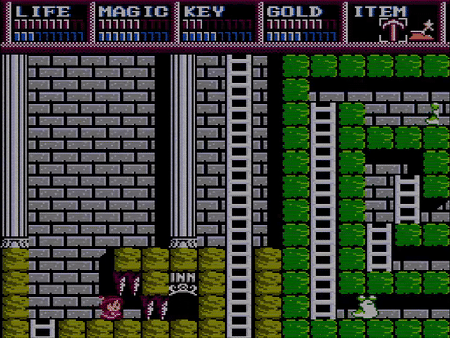
I’m not ashamed to tell you that I used a video guide to understand and finish Legacy Of The Wizard. I honestly don’t think a mortal player could finish this game in a reasonable timeframe without some form of help, and I think most would struggle to make sense of it too. Part of the issue here is that the game does very little to communicate any sense of progress or accomplishment. It’s possible you could play for tens of hours, inadvertently doing all the right things, largely heading in the right direction, but you’d just never know it, and with each passing moment of uncertainty the risk of quitting out of frustration will set in.
But maybe that’s okay? Here I am dissecting the business reasons for making a game so complicated it can’t be finished without considerable help. But what if it doesn’t matter if you actually finish it or not? When I think about my own childhood playing games and ask myself how many I finished, the answer is less than one. At a certain age, pretty much all 8-bit games felt obscure and mysterious. I’m not sure it even occurred to me that they COULD be completed, and yet I loved playing them.

If I think about Legacy Of The Wizard in that context, its complexities and complications are nothing but a selling point. Imagine a game that not only doesn’t end, but one where you really don’t know what’s around the next corner, what you might discover next or how entering a room as a different character might provide a wildly varied experience and potentially lead to a room you’ve never seen before, despite scores of hours played.
I’m extremely pleased to have played this game through to completion as an adult, and have seen all the charms and secrets it has to offer. But having done so, having unwrapped every last present, there’s nothing left to look forward to. No sense of mystery and no prospect of voyaging into the unknown. In a way, that’s a shame. If I’d played this a kid I’m certain I never would have beat it, but then the open road would have always lay ahead and I may have found myself returning to it again and again. I must admit, I’m kind of envious of that imagined version of myself.

FIVE LITTLE THINGS ABOUT LEGACY OF THE WIZARD THAT I RATHER LIKED
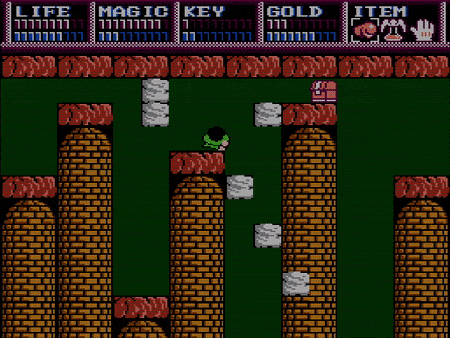
1. One of the main goals in Legacy Of The Wizard is to find and collect one of four crowns, which will then transport you to a boss battle. I love the effect where it rapidly fires you through the dungeon to the boss area. I’ve never seen anything like it in any other game.
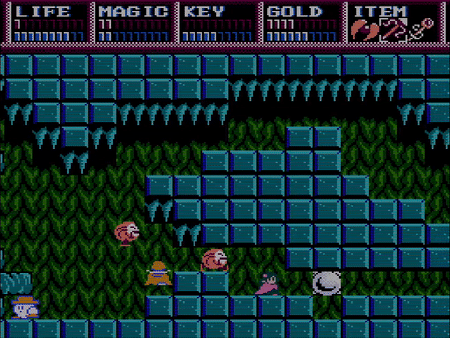
2. Meyna’s block bouncing ability can really pay off when there are enemies around!

3. I think this is one of the all-time great character select screens, and it’s one you get to enjoy repeatedly.

4. You can only take three items into the dungeon with you, so it’s important to choose carefully. I really like that you maintain control of your character on the inventory screen and simply walk up to the item you want.
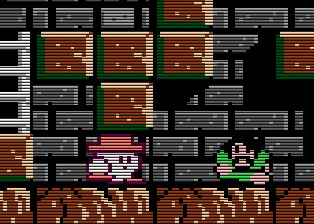
5. Is that Dizzy in a hat?
Finally, how about some music from Legacy Of The Wizard…
Follow…

Stumbled on your blog when this article showed up in a Google search for Legacy of the Wizard screenshots. I didn’t expect such a deep dive on the game and I’m glad I sat down to read it all! Followed and looking forward to checking out more of your earlier posts.
LikeLike
Awesome. Thanks so much for reading and leaving a comment. There are quite a few other Falcom games on the blog and if you like Legacy of the Wizard then the Maze of Galious post is also worth a read.
LikeLiked by 1 person
Noted. Never even heard of the game so that’s yet another for the ever-growing list.
LikeLike
Dizzy, or… Kirby in a hat?
__[ ]_
(> ‘_’ )>
LikeLike